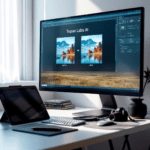Synthesia and DeepMotion basic overview
Let’s start clean and simple — these are two tools built for totally different stages of avatar creation, but people keep assuming they do similar stuff. They don’t. I bumped into that same confusion when I first tried using Synthesia avatars in motion-driven marketing clips and expected DeepMotion to somehow ‘sync’ with them automatically. Nope. It did not.
Thank you for reading this post, don't forget to subscribe!Synthesia is an AI video generator. You type out a script, choose from prebuilt avatars (or clone your own), and the system turns that into a talking head video. Its strength is speech synthesis + facial movement synced with your text input.
DeepMotion, on the other hand, focuses on motion capture. Upload a simple video of someone walking, waving, or dancing — and it maps human body/limb movement onto a 3D character. It doesn’t care what your avatar is saying. It just makes the body move like a real person.
These aren’t competitors. They’re separate pieces of a longer pipeline.
| Tool | Primary Function | Output Type |
|---|---|---|
| Synthesia | Generates avatar speech + lip sync | MP4 video of avatar speaking |
| DeepMotion | Captures full-body motion from video | 3D rigged animation (FBX, GLB) |
At the end of the day, it’s more like a peanut butter and jelly setup. You need both to make something that looks both alive and human-controlled.
Lip sync vs body motion accuracy
The first honest thing to say here: Synthesia’s lip sync is surprisingly good given that you don’t record anything. You feed it a script, pick a voice (I used “Olivia” for several tests), and it creates the facial expression, blinking, and head tilt timed to that speech. There’s no hassle with microphones or retakes. BUT — arms? Legs? Forget it. The avatar just stands still, only the shoulders wobble slightly when certain consonants hit, like “t” or “g.”
DeepMotion’s accuracy lies on the opposite end. It nails small limb movements from very low-res webcam clips. I recorded myself doing a talk with minor hand gestures, uploaded that to DeepMotion, and it auto rigged a stylized character that moved eerily like me — even capturing the way I tend to drop one shoulder while talking. There were some shoulder jitter issues when I wore loose clothing (the system confused shirt folds for joint boundaries). And if lighting was uneven, the character’s foot placement would slide or tilt unnaturally.
Side-by-side testing revealed that:
- Synthesia avatars always keep their center line perfectly still. They won’t walk or shift weight — even if your script implies excitement or urgency.
- DeepMotion avatars move more authentically but are mute. No facial animation. The mouth doesn’t even open. It’s just body rhythm.
To wrap up, each tool masters only half the equation: one talks convincingly, the other moves believably — but neither does both well out-of-the-box.
Requirements for avatar compatibility
If you’re thinking — “Cool, I’ll just export from Synthesia and pipe that into DeepMotion” — that’s what I thought too. Turns out: you can’t. At least not simply. Synthesia does not export the avatars as 3D models. You only get flat .mp4 videos. No FBX, no mesh files, no skeleton rig.
That disqualifies direct avatar transfer.
To make Synthesia and DeepMotion work together, the common workaround I ended up using was:
- Create body motion using DeepMotion with a dummy model.
- Export that animation as FBX.
- Import the FBX into Blender (or Unity).
- Manually attach a custom avatar that looks similar to Synthesia’s — often using stock Mixamo characters.
- Synchronize Synthesia’s head+voice video as a front-overlay or billboard texture above the 3D model.
Is this clean? Not at all. It’s hacky layering and you lose any real connection between the lip sync and limb motion. They’re just playing at the same time.
If your goal is to have a realistic presenter who gestures while speaking, you’re better off using something like Reallusion’s iClone which supports both.
To conclude, there’s currently no native way to merge Synthesia and DeepMotion avatars — unless you’re doing post-production stitching in a 3D suite.
Performance in remote team presentations
I tested both tools in the context of remote team briefings — where I needed short videos to explain feature rollouts without jumping into Zoom. Synthesia was plug-and-play. I wrote a one-paragraph update, rendered it in under ten minutes, and pasted the mp4 in our Slack channel. Nobody questioned the lack of movement. The team just appreciated that it was clear, face-led, and had a real voice attached.
With DeepMotion, I tried to spice things up for a quarterly update: I filmed myself pacing, pointing at the air (pretending there were slides), and uploaded that to DeepMotion. The final rigging was slick but had a few palm orientation glitches (my actual hand was open, but the animated hand kept forming fists). I had to fix that in After Effects — and by then, the animation felt slightly over-produced for internal use.
Here’s how the feedback differed:
| Metric | Synthesia | DeepMotion |
|---|---|---|
| Speed of creation | Very high — no retakes or rigging | Medium — needs source video + fixes |
| Viewer engagement (internal) | Neutral-positive — gets the job done | Mixed — cool but “why so cinematic?” |
Ultimately, Synthesia wins for quick, info-centric updates, while DeepMotion feels more theatrical — something I’d reserve for public-facing media or creative internal sprints.
Exporting workflows and platform compatibility
This one got me stuck initially. Knowing which tool exports to what format matters hugely if you plan to import into editing software or game engines. Here’s what I confirmed—and yes, I had to force-convert some files along the way:
- Synthesia: Exports only as rendered .mp4 video, in standard resolutions like 1080p. No separate audio tracks. No alpha channel. That means you can’t overlay the avatar on transparent backgrounds unless you do green screen masking (and the results are… meh).
- DeepMotion: Offers .FBX and .GLB formats. That means you can drop the output right into Unity, Unreal, or Blender — assuming you have a compatible rigged mesh. You will need to provide your own 3D character or use the free ones from Mixamo or ReadyPlayerMe.
If you’re aiming for serious compositing work — like combining avatars into virtual scenes — Synthesia becomes the bottleneck. I tried rotoscoping the background out of a Synthesia avatar to place into a Unity project. Even with AI masking in RunwayML, the edge textures flickered. Hair strands clipped weirdly, especially with blond avatars.
One workaround is to take the audio-only from Synthesia and apply it to a DeepMotion-rigged avatar. That assumes you can bake lip sync into facial bones — which isn’t standard in DeepMotion. You’ll need additional software like AccuLips for that.
In a nutshell, DeepMotion is far more flexible for gaming/dev work; Synthesia stays locked to static backdrop video unless you go through laborious masking.
Use cases where they shine best
In my experience running small campaigns, these are the use cases where each tool absolutely nailed it:
Synthesia:
- Training videos where the speaker needs to be calm, neutral, and authoritative — like product updates or onboarding scripts.
- Multilingual explainers. I created a 3-minute clip in six languages without hiring a single translator or voiceover talent.
- Compliance explainer videos where consistency, not excitement, matters most. No loud animations, just clean talking heads.
DeepMotion:
- Animated shorts or brand intros where movement is critical — like a character walking into the scene and interacting with an object.
- Virtual events or storytelling content where you want depth of gesture (e.g., a teacher pacing while explaining a topic).
- Game character prototyping where you record your own movements to map onto NPCs or create animated trailers of in-game actions.
As a final point, they both bring value — but only deliver their full power when pointed at the right job.
Best choice depending on your workflow
If your workflow prioritizes voice + clarity — go Synthesia. It’s stable, smooth, and gives consistent results that are super fast to produce. It’s not cinematic. That’s the point. If you want someone to listen to what’s being said instead of watching a character dance around, this is the better choice.
If your workflow demands puppet motion or theatrical scene-building — DeepMotion will give you that visceral body presence. As long as you’re okay with manually syncing audio or skipping it completely, it shines in places where physical expression carries the mood.
The bottom line is, they aren’t better or worse than each other — they just solve very different problems, and only overlap when you’re willing to hand-stitch output across tools.





